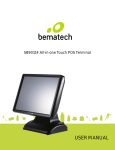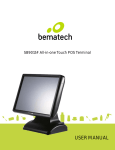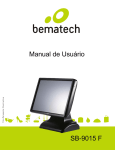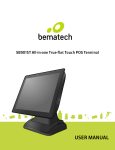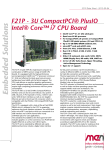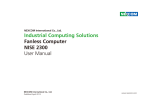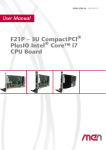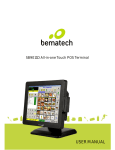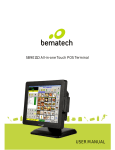Download Crate CSM16 User manual
Transcript
SB9015F All-in-one Touch POS Terminal (i3 Processor) USER MANUAL Table of Contents 1 Introduction ...................................................................................... 2 1.1 1.2 Safety Information ........................................................................................ 2 Electromagnetic compatibility statement ................................................. 3 2 Overview ............................................................................................ 4 2.1 2.2 2.3 2.4 Appearances .................................................................................................... 4 Rear panel I/O connectors ............................................................................. 5 Rear View ......................................................................................................... 6 Control Panel ...................................................................................................7 3 Hardware Installation ....................................................................... 8 3.1 3.2 3.3 3.4 3.5 3.6 Cable Routing.................................................................................................. 8 Installing MSR................................................................................................. 8 Installing Customer Display .......................................................................... 9 Installing Second LCD .................................................................................... 9 Replacing System Core ................................................................................. 10 Replacing Hard Disk Drive ............................................................................ 10 4 Setup and Driver Installation .......................................................... 11 4.1 4.2 4.3 4.4 4.5 Cash Drawer Port ............................................................................................11 Serial Ports Configurations .......................................................................... 12 Jumper settings ............................................................................................. 12 Motherboard BIOS settings ......................................................................... 15 Touch screen driver installation ................................................................. 20 5 Troubleshooting .............................................................................. 28 6 Specifications ................................................................................... 31 1 1 Introduction Thank you for purchasing the SB9015F(i3) all-in-one touch POS terminal, Bematech is committed to continuously improve product quality and provide better after-sales service. In order to take full advantage of our devices, we strongly recommend that you take the time to read this manual before diving into software solution. Note: Information in this manual may change without prior notice. 1.1 Safety Information Before plug in the product, please make sure the power you provide meets the power requirements (such as voltage, frequency); Make sure the ground terminal of the power outlet is working properly. To avoid electric shocks, disconnect the power cord from the electrical outlet before relocating the system. Lightning may damage this product. During lightning storms, unplug the network cable, power cable and any other connections. Turn off power before connecting any devices (except USB devices) to the terminal. Do not attempt to open the chassis. You may be hurt by electric shock. For service, call your place of purchase. Do not spill liquid on the terminal. Do not place any objects into the ventilation holes of this product. It may cause short-circuit of the internal components and cause a fire or electric shock. After the terminal is stored below temperature of 10 ° C, please place it in room temperature (10-35 ° C) in the original packing for at least two hours to allow the terminal to restore to room temperature before operation. This is to avoid condensation that might cause electrical damage. Keep the terminal clean, dry, and away from dust, moisture and direct sunlight. 2 Do not use harsh chemicals or strong cleaning solvents to clean the monitor screen. Wipe it clean with a soft terry cloth applied with a mild solution Do not share the same power outlet with high-power electrical appliances; keep distance from high level magnetic interference. Do not the use sharp pointed objects to work with the touch screen to avoid damage to the screen. When the following occurs: Liquid gets inside the POS terminal; Accidental physical damage; The power cord or plug is damaged; POS terminal produces a burning smell; Immediately disconnect the power supply, unplug the power cord, and contact a qualified service technician. 1.2 Electromagnetic compatibility statement FCC NOTICE This device complies with Part 15 of FCC Rules. Operations are subject to the following two conditions: (1) this device may not cause harmful interference, and (2) this device must accept any interference received, including interference that may cause undesired operation. EUROPEAN COMMUNITY (CE) MARK OF CONFORMITY This product is in conformity with the protection requirements of EU Council Directive 89/336/EEC on the approximation of the laws of the Member States relating to electromagnetic compatibility. Logic Controls cannot accept responsibility for any failure to satisfy the protection requirements resulting from a non-recommended modification of the product. This product has been tested and found to comply with the limits for Class A Information Technology Equipment according to CISPR 22 / European Standard EN 55022. The limits for Class A equipment were derived for commercial and industrial environments to provide reasonable protection against interference with licensed communication equipment. 3 2 Overview 2.1 Appearances 4 2.2 Rear panel I/O connectors At the rear panel of the SB9015F is a row of external I/O device connectors detailed as follows: 1 DC in 2 HDD slot 3 DC out (for 2nd LCD) 4 Line out 5 Cash drawer port 6 COM5 7 USB port x 4 8 LAN port 9 COM1 10 COM2 11 COM6 12 VGA port 13 PS/2 keyboard port 5 2.3 Rear View 1 VESA holes 2 MSR module compartment 3 Speakers 4 VESA routing plate 5 Control panel 6 Display module compartment (for Customer display or 2nd LCD) 6 2.4 Control Panel 1 Brightness – Press the “Brightness –” button to decrease brightness. The setting will be saved 6 seconds after releasing the button. 2 Brightness + Press the “Brightness +” button to increase brightness. The setting will be saved 6 seconds after releasing the button. 3 USB ports Connect external peripherals such as a memory drive. 4 Power Button Press to turn the POS terminal on or off. The LED lights up blue when the power is on. Note: Press the “Brightness –” and “Brightness +” buttons at the same time to restore brightness to the factory default setting. 7 3 Hardware Installation 3.1 Cable Routing 3.2 Installing MSR 8 3.3 Installing Customer Display 3.4 Installing Second LCD 9 3.5 Replacing System Core 3.6 Replacing Hard Disk Drive 10 4 Setup and Driver Installation 4.1 Cash Drawer Port Pin-out 6 Pin 1 2 3 4 5 6 1 Description Sense input 2 Drive output 1 Sense input 1 +24V/+12V Drive output 2 Ground Note: The Y cable used to support two cash drawers on the single RJ-11 socket is same as that for Epson printers. Operation The Cash Drawer Controller use one I/O address to control the Cash Drawer. I/O address Attribute Size 48Ch Read/Write 8 bits 11 4.2 Serial Ports Configurations Connectors COM1 COM2 COM3 COM4 COM5 COM6 Function External, RS232 External, RS232 Customer Display External, RS232 (RJ45) Touch controller External, RS232 Pin 9 Power Support RI/+5V/+12V select by jumper RI/+5V/+12V select by jumper +5V only RI/+5V/+12V select by jumper +5V only RI/+5V/+12V select by jumper COM4 RJ45 Socket Pin Assignment RJ45-10 Pin No. Signal Name 1 NC, or +5/+12 VDC 2 GND 3 DTR 4 CTS 5 TX 6 RTS 7 RX 8 DSR 9 DCD 10 NC 4.3 Jumper settings JP3 - Clear CMOS Contents 1-2 Normal 2-3 Clear CMOS 12 Default=Normal JP6 - CN7 Cash Drawer Power Selection 1-2 +24V 2-3 +12V JP7 - CN1 USB Power Selection 1-2 +5VSB 2-3 Default=+5VSB +5V JP8 - CN4 USB Power Selection 1-2 +5VSB 2-3 Default=+24V Default=+5VSB +5V JP9 - COM4 RS232 pin 9 function select 1-2 RI 3-4 +5V 5-6 +12V Default=RI JP10 - COM6 RS232 pin 9 function select 1-2 RI 3-4 +5V 5-6 +12V Default=RI JP11 - COM2 RS232 pin 9 function select 1-2 RI 3-4 +5V 5-6 +12V Default=RI JP12 - COM1 RS232 pin 9 function select 1-2 RI 3-4 +5V 5-6 +12V Default=RI 13 JP13 - PS/2 Keyboard Power Selection 1-2 +5VSB 2-3 +5V Default=+5VSB Note: Do not plug in or unplug any connector except USB devices when the power is on. The current loading for all COM ports should not exceed DC 5V/3A and DC 12V/2A. 14 4.4 Motherboard BIOS settings The POS terminal has a BIOS (Basic Input Output System) chip on the motherboard. Every time you start the terminals, the system will first run the BIOS self-test routine to check the main components of the system to ensure it is working properly. The terminal is loaded with default BIOS settings in the factory. change the parameters in the BIOS unless necessary. Please do not In the following situations, you need to run the BIOS setup: 1) Error message appears on the screen during the system self-test and requested to enter BIOS setup. 2) If you need to change the factory default settings to customized application requirements (for example, boot device priorities). Control keys <↑> Move up to previous item <↓> Move down to next item <←> Move left to previous menu <→> Move right to next menu <Enter> Select this option/sub-menu <+> Increase the option value or change selection <-> Reduce the option value or change selection <F1> Help <F2> Restore previous values <F3> Load optimized default values <F4> Save and Exit <Esc> Exit the menu or to return to the main menu from the submenu 15 Main Menu System Time and Date Setting: Under <Main>, select < System Date > or <System Time> to change the system date and time. Main Advanced Chipset Boot Security Save & Exit BIOS INFORMATION Build date and time 05/14/2013 19:02:18 BIOS Version J1G → ←Select Screen ↑↓ Select Item System Date [Tue 01/06/2009] Enter: Select System Time [00:08:21] +- Change Field F1:General Help F2:Previous Values Access Level Administrator F3: Optimized Default F4: Save & Exit ESC: Exit Advanced Tab ACPI Suspend Type Setting: Under <Advanced>, select <ACPI Setting >, select < ACPI Sleep State > configure S3 to S1. Main Advanced Chipset Boot Security Save & Exit → ←Select Screen Enable Hibernation Enabled ↑↓ Select Item ACPI Sleep State S3 (only suspend to…) Enter: Select +- Change Field F1:General Help F2:Previous Values F3: Optimized Default F4: Save & Exit ESC: Exit 16 AHCI Setting: Under < Advanced >, select <SATA Mode Selection>. Main Advanced Chipset Boot Security Save & Exit SATA Controllers(s) Enabled Enable or disable SATA Device SATA Mode Selection IDE Serial ATA Port 0 Empty → ←Select Screen Software Preserve Unknown ↑↓ Select Item Serial ATA Port 1 Empty Software Preserve Unknown Enter: Select +- Change Field F1:General Help F2:Previous Values F3: Optimized Default F4: Save & Exit ESC: Exit Hardware Monitor Check: Under < Advanced >, select < F81866 H/W Monitor >. Main Advanced Chipset Boot Security Save & Exit PC Health Status → ←Select Screen CPU temperature +39 C ↑↓ Select Item System temperature +42 C Enter: Select Sys_FAN Speed 6602 RPM Vcore +1.128 V F2:Previous Values VCC5V +5.043 V F3: Optimized Default VCC12V +12.058 V F4: Save & Exit +1.5V +1.524 V VCC3V +3.374 V +- Change Field F1:General Help 17 ESC: Exit Com and Parallel Port IRQ Setting: Under < Advanced >, select < F81866 Super IO Configuration >. Main Advanced Chipset Boot Security Save & Exit Super IO Configuration → ←Select Screen F81866 Super IO Chip ↑↓ Select Item F81866 Enter: Select ► Serial Port 0 Configuration +- Change Field ► Serial Port 1 Configuration F1:General Help ► Serial Port 2 Configuration F2:Previous Values ► Serial Port 3 Configuration F3: Optimized Default ► Serial Port 4 Configuration F4: Save & Exit ► Serial Port 5 Configuration ESC: Exit ► Parallel Port Configuration Power Failure Always off Boot Tab Use <+> and <-> to arrange the boot sequence. more information. See the BIOS documentation for Main Advanced Chipset Boot Security Save & Exit Boot Configuration Setup Prompt Timeout 1 Bootup NumLock State On → ←Select Screen ↑↓ Select Item CSM16 Module Version 07.69 Enter: Select +- Change Field F1:General Help GateA20 Active Upon Request F2:Previous Values F3: Optimized Default Boot Option Priorities F4: Save & Exit ESC: Exit ► CSM parameters 18 Security Tab Set the Supervisor or User password first to use the security features. Main Advanced Chipset Boot Security Save & Exit Password Description If ONLY the Administrator’s password is set, then this only limit access to Setup and is only asked for when entering Setup. → ←Select Screen If ONLY the User’s password is set, then this ↑↓ Select Item is a power on password and must be entered to Enter: Select boot or enter Setup. In Setup the User will have +- Change Field Administrator rights F1:General Help The password length must be F2:Previous Values in the following range: F3: Optimized Default Minimum length 3 F4: Save & Exit Maximum length 20 ESC: Exit Administrator Password User Password Save& Exit Restore the Factory Default Setting: Under <Save & Exit>, select < Restore Defaults > and select <Yes>. Main Advanced Chipset Boot Security Save & Exit Save Changes and Reset Discard Changes and Reset → ←Select Screen Save Options ↑↓ Select Item Save Changes Enter: Select +- Change Field Discard Changes F1:General Help F2:Previous Values Restore Defaults F3: Optimized Default Save as User Defaults F4: Save & Exit Restore User Defaults ESC: Exit 19 4.5 Touch screen driver installation Step 1: Navigate to the installer directory to find the setup.exe file. Double-click on “setup.exe” to start installation. Step 2: When installation starts, click [Next] to proceed to the next step. Step 3: Installation in progress 20 Step 4: Uncheck “Install PS/2 interface driver” and click [Next] to continue installation. Step 5: Uncheck “install RS232 interface driver” and click [Next] to continue installation. 21 Step 6: Select option “NONE”, click [Next] to continue installation. Step 7: When installing USB touch, please connect the USB controller and USB cable 22 Step 8: If there are additional touch monitors connected, please check “Support multi- monitor system”. Step 9: Select the destination location to install the touch driver. The default path is “C: \ Program Files \ eGalaxtouch”. Click [Next] to continue installation. 23 Step 10: Select the Program Folder to install the utility. “eGalaxtouch”. Click [Next] to continue installation. Step 11: Check the option to create a desktop shortcut icon. 24 The default is After install the driver successfully, identify the USB controller is installed as shown below. Touch function settings 25 Touch calibration Touch device line test 26 27 5 Troubleshooting 1) Terminal does not boot If the terminal cannot boot after repeated pressing of the power switch when connect to the power, the terminal power light remains off, the fan does not operate, and the BIOS beeping is not heard, it might be power supply problems. (a) Check the power adapter is plugged in correctly to the power outlet. (b) Check the connection between the terminal and the power adapter, and then re-boot the machine. (c) If the terminal is working in high temperature environment that causes the terminal automatically shut down in protection mode, please disconnect the power of the machine. Wait until environment temperature has dropped and restart. (d) If the terminal does not boot after a sudden power failure or illegal shutdown, unplug the adapter from the terminal, and press the power button several times. Then plug in the adapter and boot again. (e) If the adapter light blinks or go off, unplug the adapter immediately and do not plugged in again. Contact with our products service center. 2) The terminal automatically restart (or shutdown) If terminal is frequently automatic shutdown or auto-boot during operation (or boot up), (a) Check the power supply is connected properly; make sure the plug is not loose and contacts are in good condition; (b) Check if the AC line voltage is stable; (c) A sudden power failure or improper shutdown may cause this problem. Press F8 to boot system into safe mode and debug. (d) If any new hardware is added or replaced that caused this problem, remove the hardware and reboot; 28 (e) If the above steps do not resolve this problem, reinstall the operating system. 3) The touch screen does not respond (a) Remove the touch driver and then install it again. (b) Execute the “eGalaxTouch utility and check if the interface port is working. 4) When touching the screen, cursor always returns to a fixed position. (a) Check if there is anything pressing on the touch screen. (b) Other high power or high frequency equipment may affect the screen or controller. Make sure that the touch screen is away from the high-voltage equipment. (c) The touch screen driver is not installed correctly, install the driver (please refer to the "Touch Screen Setup") and run a 25-point calibration. 5) Touch screen is not accurate Please run the touch screen calibration program with a 25-point recalibration, we also recommend you to do this after change the monitor resolution or refresh rate. When running the calibration, touch the center of calibration point to assure accuracy. 6) The cursor moves opposite to the touch movement (a) Run the 4/9/25 point calibration. (b) The touch screen driver is not installed properly, reinstall the driver. 7) The cursor fixed at the edge of LCD (a) Check if the edge of the screen is being pressed by something. (b) Check the edges of the LCD if there is anything jammed in the front bezel. (c) Make sure the touch screen is clean. 29 8) The cursor in the touch screen can only move in a small area or touch positions are inaccurate. (a) This situation usually occurs first time after installing the driver. Please run the touch screen calibration program. We also recommend you to do this after changing monitor resolution. (b) Run the touch screen calibration program to do a 25-point recalibration. 30 6 Specifications MODEL Main Board CPU System Chipset Memory Storage Display LCD panel Resolution Brightness Touch Screen Tilting Angle I/O Ports External DC Input PS/2 Port Serial Ports SB9015F 15” i3 All-in-one Touch POS Terminal Intel i3-2310E Processor dual core 2.1GHz HM65 2 slots, DDR3 1066/1333, up to 4GB SATA 2.5 inch Hard Disk Drive, 320GB or higher 15” TFT LCD 1024x768 2 250cd/m 5-wire resistive touch (RS232 interface) 0 to 90° 1x DC jack (connected to power adapter) 1x PS/2 keyboard 3x DB9 with DC5V/12V on pin 9 (jumper option), 1x RJ45 Optional 1x DB25 on cable 1x DB15 2nd video VGA connector 1x RJ45, 10/100M/1Gbit 6x USB 2.0 1x RJ11, 12V/24V jumper selectable 1x audio out, 2x 1W built-in speaker 1x DC 12V output Parallel Port VGA LAN USB Cash Drawer Port Audio DC Output Environment Operating Temperature 0°C to 40°C Storage Temperature -25°C to 70°C Relative Humidity 8% to 80% non-condensing Electrical (External Power Adapter) Input 100V to 240VAC, 50 to 60Hz, 2.0A Output DC 24V 5A Output Power 120W max Mechanical Dimensions 329x348x213mm Weight 10Kg 31 SB9015F All-in-one Touch POS terminal 32

































